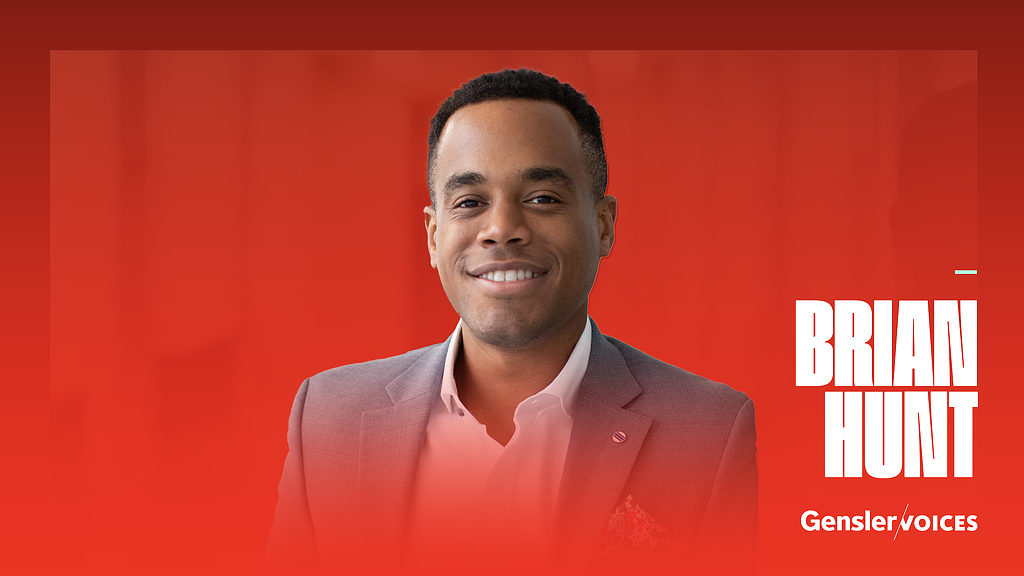Gensler Voices: Brian Hunt on How Sports Have Influenced His Design Career
November 15, 2023
This Q&A is part of a series of interviews with Gensler architects, designers, and others in the firm about their career journey, and the impact that design and architecture can have on our communities and the human experience. Here, we sit down with Brian Hunt, a designer in our Chicago office:
How were you first introduced to architecture and design?
I've always been a sports fanatic. Growing up I would study baseball ballparks and their design quirks. I found myself filling sketchbooks with plans and vignettes of stadiums, researching both historical and modern-day layouts. My father and I made the goal to visit all 30 major league baseball parks when I was about 10 years old. Over subsequent summers we tried to visit at least one new park together to watch a game. Each new stadium and urban environment further piqued my interest in architecture and design. I still have a few stadiums to check-off the list, today.
How can architecture and design make space that’s inclusive for everyone?
We design for people. Building teams with diverse backgrounds can help to provide different perspectives and ensure that we are considering the needs of people with different abilities, backgrounds, genders, and cultures with the goal of making a more inclusive experience for everyone. As designers, it's important to realize that there is not a 'one size fits all' solution–we should tailor spaces to accommodate the unique people who will be using them.
Did you have a mentor growing up or at any point during your career? If so, how did that relationship impact your growth as a person or in the industry at large?
I've had countless mentors and advocates over the course of my career; too many to name. One of my early mentor relationships taught me the ins-and-outs of being a professional. The focus, dedication, and attention to detail required to be successful in any field, but especially architecture. There was a level of trust between my mentor and me–she was able to have difficult conversations with me and push me to be better without sugar-coating. Tough love. This also taught me to value relationships, build my personal network, and make a concentrated effort to ALWAYS follow through.
What do you think are the most important skills to succeed in architecture?
- The ability to adapt and be flexible. Be able to think on your feet to develop creative solutions.
- Also, the balance of design and technical knowledge–it's important to understand how elements are constructed–this will inform better design solutions.
- Be able to visualize and think three-dimensionally. How does that detail join or transition? How does that finish reinforce the overall concept and broader design?
- And finally, communication both with our internal teams, consultant teams, and to the client is vital. Being able to articulate ideas verbally and graphically, clearly, and concisely.
How do diverse backgrounds and experiences make Gensler a better design firm?
I believe our diversity, equity, and inclusive efforts make us a much stronger design firm. When we surround ourselves with people who bring a wide range of ideas to the table and are willing to challenge the norm, we create a more innovative product. We draw upon the varied backgrounds, perspectives, and experiences of our team members to help address some often-complicated global design and socio-economic challenges. These insights are an increasing expectation from our clients, so I’m proud that Gensler is a leader in our industry.
What are you most excited for when it comes to the future of architecture and design?
Focusing on workplace design, I am excited to take part in addressing the rapidly changing workforce, and the physical and digital spatial adaptations that come along with it. Advancements in technology and a re-prioritization in well-being has driven our field forward. I believe that spaces should be geared towards providing greater accessibility, comfort, and functionality.
Most career journeys aren’t linear. What has yours looked like?
My career started at the University of Maryland, where I earned my bachelor’s degree in architecture and minor in sustainable studies. Throughout my college semesters I balanced an internship with a full-time course load which taught me practical design skills along with time management!
Professionally, I've worked in Baltimore, D.C., and now Chicago, on a variety of project types, from hospitality, retail, senior living, building repositioning to workplace interiors. I was able to gain experience working on all phases of a project – there were a lot of lessons learned and teachable moments, but this involvement helped me to progress as an architect.
One of my career goals has always been licensure. At the start of the pandemic, I realized there was never a better time to focus on myself and dedicate my efforts to achieving this milestone. After many ups and downs and countless hours of studying I was able to achieve licensure and use this as a steppingstone for my future.
All of these experiences have led me to the position I am in today.
For media inquiries, email .
